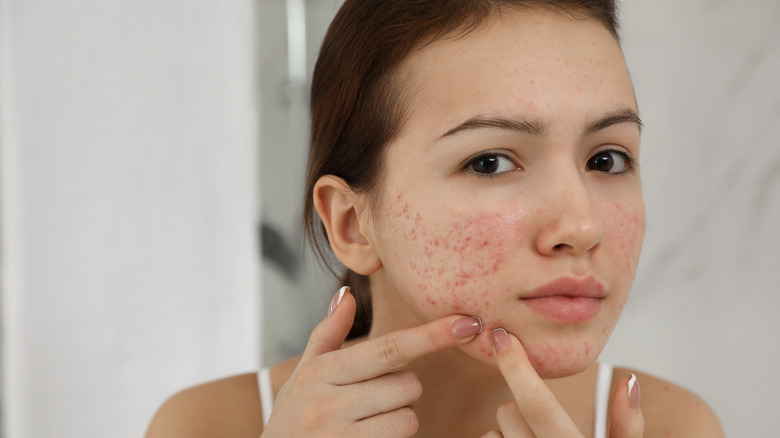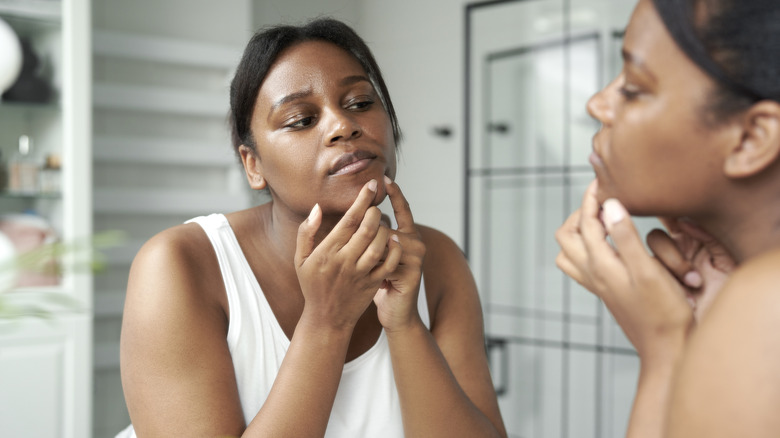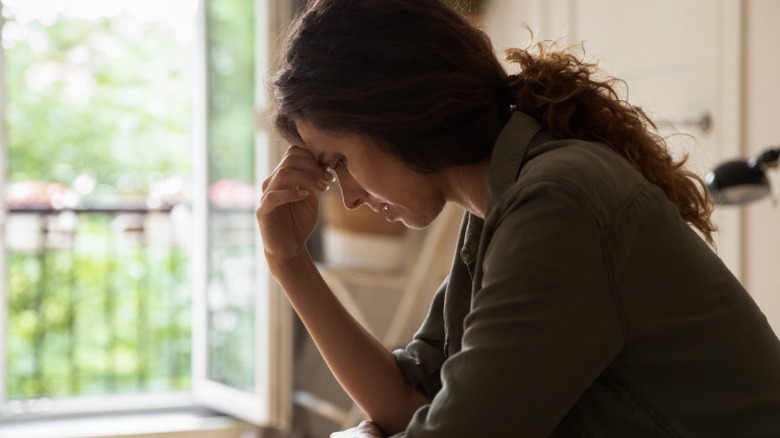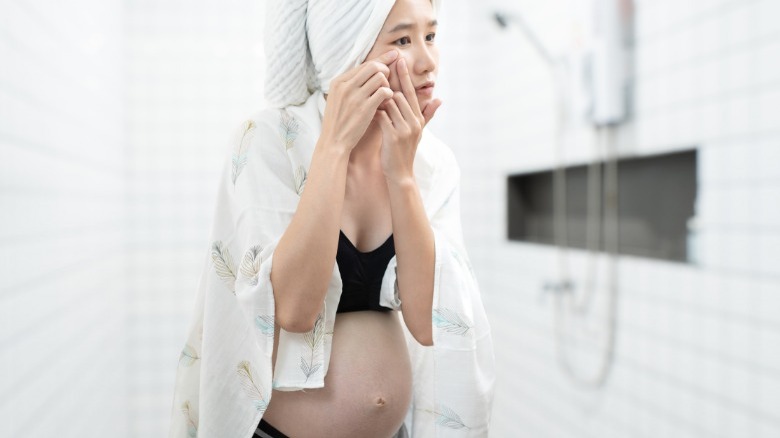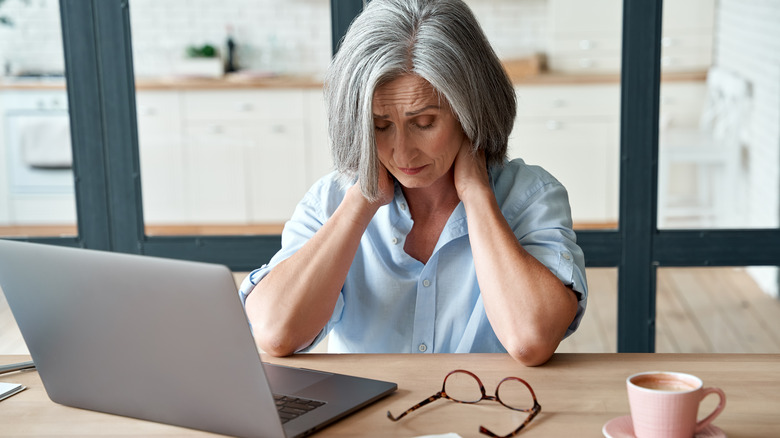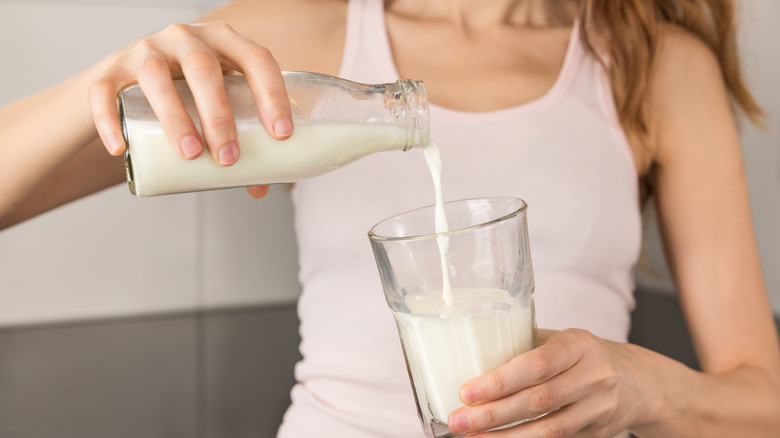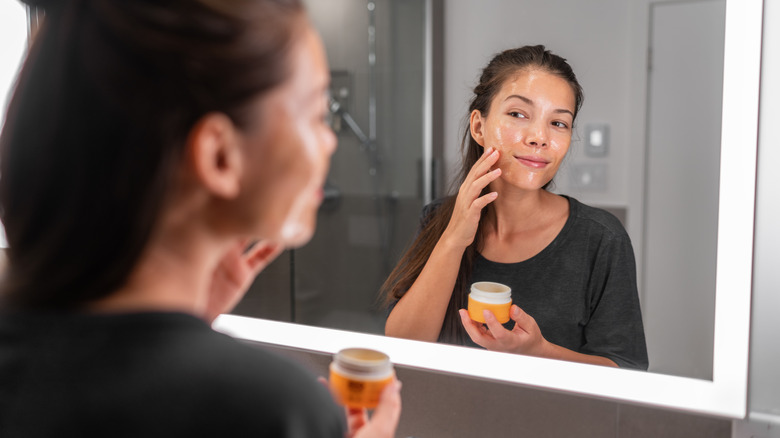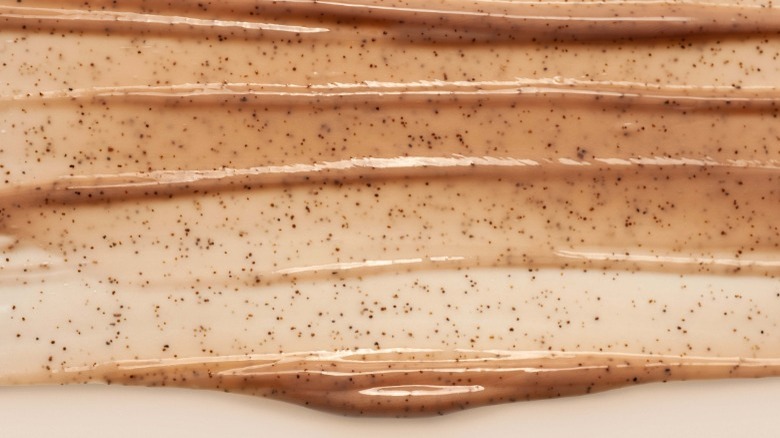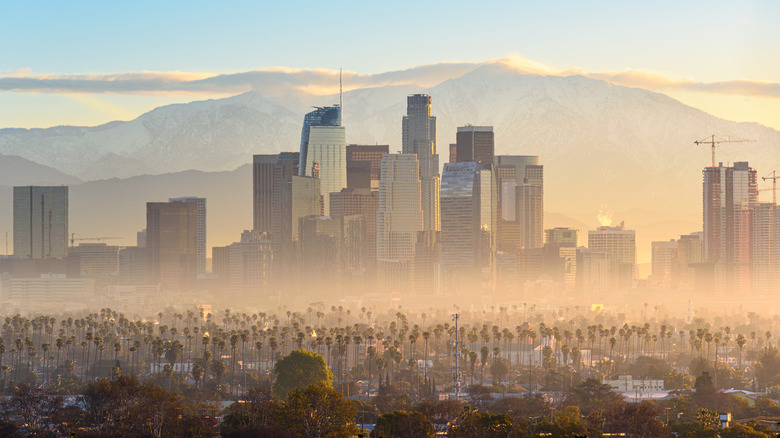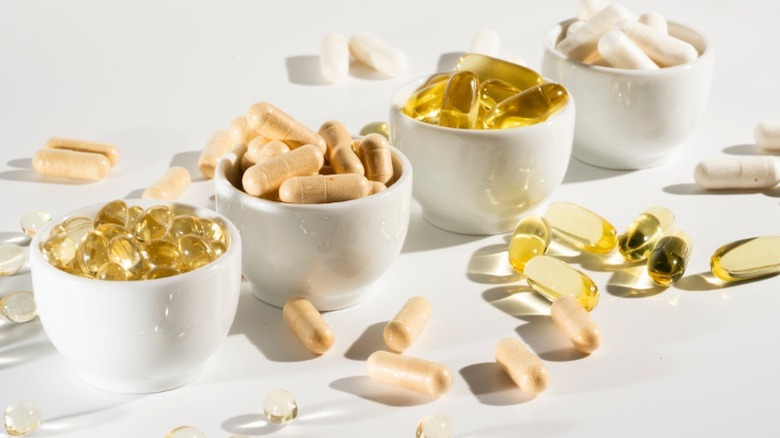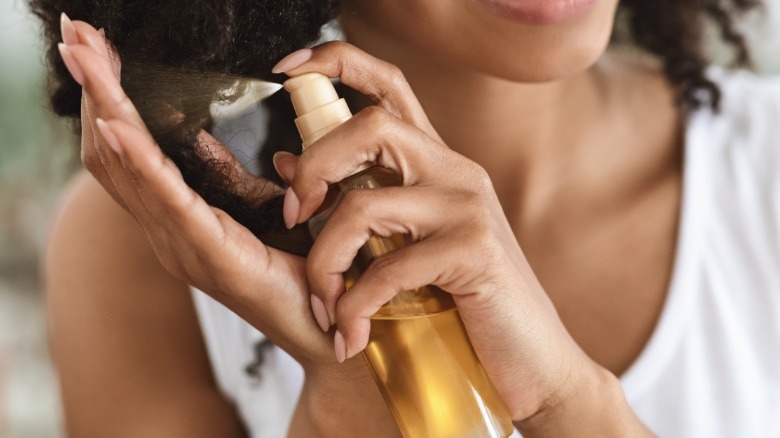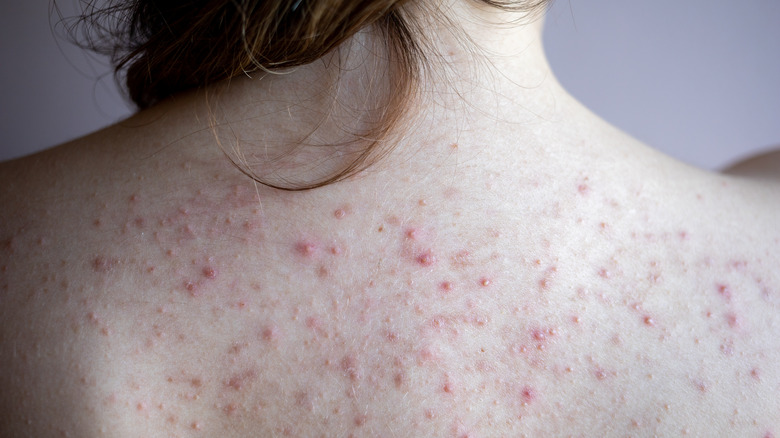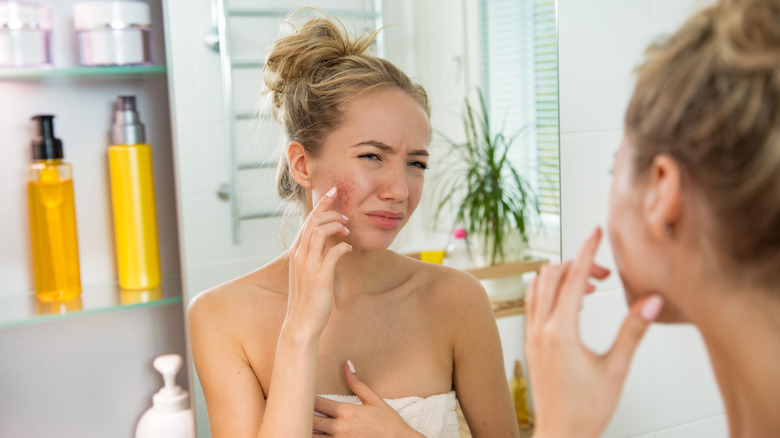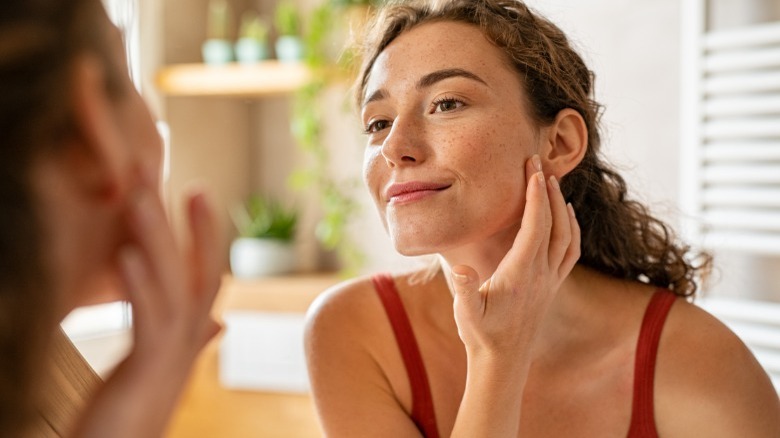Adult Acne: What To Know About The Frustrating Skin Condition
For many women, having to deal with embarrassing breakouts as a teen was a difficult stage. But as they moved into adulthood, those acne flare-ups subsided and their skin eventually cleared up. However, those struggles, unfortunately, didn't end for everyone after puberty. Some adults well into their 30s and beyond face an onslaught of stubborn pimples from recurring adult acne breakouts.
Adult acne can range from mild to severe, with occasional blackheads and whiteheads to full-blown cysts and extreme irritation. These pimples and lesions form on the skin because glands become clogged with oil and dead skin cells and then become infected, which results in swelling, redness, and pus.
Nobody wants to deal with adult acne. Between busy work schedules, family time, social life, and staying active, the last thing you need is to worry about zits on your skin. Unfortunately, some things you do on a daily basis may be contributing to adult acne or causing it to become worse. Here's what women should know about acne as an adult and what you can do to ease some of its symptoms.
It's more common than you might think
If you struggle with adult acne, it's easy to feel like you're the only one with this problem. Because it's typically associated with adolescence, dealing with breakouts as an adult can be isolating when it seems like everyone around you has perfectly clear skin. The truth is that adult female acne is on the rise. A study in "The Journal of Clinical and Aesthetic Dermatology" found that a disproportionate 85% of people who suffer from adult acne are female (via National Library of Medicine).
The American Academy of Dermatology (AAD) shares that up to 15% of all women are affected by adult acne. In most cases, adult acne carries over from adolescence into adulthood. Some women will experience acne as a teen, followed by a period of clear skin, then the breakouts will return. Some women who never had acne during puberty will develop this skin condition after the age of 25.
Adult acne can take a serious emotional toll
Adult acne is so much more than a simple inconvenience. Redness, inflammation, and blemishes on the face can physically and emotionally affect women — regardless of the severity of the acne. For some, a small breakout is enough to keep them from enjoying social outings, pursuing a romantic relationship, or even feeling confident enough to move up in their careers.
According to the American Academy of Dermatology Association (AAD), people with acne often suffer from depression, anxiety, low self-esteem, isolation, poor self-image, and an overall decreased quality of life. Because it can be distressing to have to hide your face and feel like you're being judged whenever you talk to someone, acne can definitely take a toll on a person's mental health. Another study published in the "Indian Journal of Dermatology" found that female test subjects with acne had high levels of physical discomfort and anger associated with the condition (via National Library of Medicine). The study recommends that dermatologists should use a sympathetic approach during treatment that considers the emotional state of women with acne.
Adult acne can be emotionally scarring and leave you feeling down on yourself. If you're struggling with depression and anxiety because of acne, studies show that your feelings are absolutely valid, and you may benefit from support for your mental health.
Hormonal changes are the main cause of adult acne
While there are several factors that may contribute to adult acne, breakouts are mainly caused by shifts in hormones. When the body experiences hormonal shifts, skin glands may start to overproduce oil or sebum. The excess sebum can trap bacteria and dead skin cells in your pores and hair follicles, which leads to skin inflammation and pimples.
In women, changes in estrogen levels and other hormonal shifts can happen during regular menstrual cycles, before, during, and after pregnancy, and while going through menopause. Women who suffer from polycystic ovary syndrome and irregular menstrual cycles are also more prone to acne. Likewise, you may notice a change in your skin when you start or stop using hormonal birth control methods.
Changes in hormones are typically strongest when women are pregnant or during menopause, which makes it more likely that you will experience adult acne during these stages in your life. However, anything you do that fluctuates your normal balance of hormones can result in sudden breakouts on the face and body. For example, not getting enough restorative sleep can disrupt your hormones enough to cause an adult acne flare-up.
Stress often triggers adult acne symptoms
Chronic stress can be incredibly harmful to the body and mind, causing serious health issues and increasing the risk of certain conditions. It can also lead to weight fluctuations, heart disease, reproductive issues, depression, digestive conditions, and cognitive problems. As if all that wasn't bad enough, it turns out that stress can also exacerbate adult acne breakouts.
Although it doesn't directly cause acne, stress can show on your skin in negative ways. According to Medical News Today, because stress significantly impacts the immune system and the body's hormonal balance, it can cause inflammation of the oil-producing glands. This is likely to result in more skin sebum, gland irritation, and a reduced ability of the skin to fight infections.
Because stress can affect the occurrence of adult acne, you may find that managing your stress levels can help lessen the severity of your breakouts. A study published in the "International Journal of Dermatology" found that female patients with acne showed significant improvement in acne symptoms by practicing stress management techniques (via Wiley Online Library). If you're finding it difficult to handle daily stresses, talk to your doctor about ways you can relieve stress and boost your skin health.
Sugary foods may cause acne flare-ups
Having too much sugar and processed food in your diet is generally not good for your health. Foods that are high on the glycemic index cause a sudden spike in blood sugar levels and a rapid release of insulin to counter it. The American Academy of Dermatology Association (AAD) also shares that high-glycemic diets may be contributing to acne breakouts. This is because foods and beverages loaded with sugar and simple carbohydrates increase blood sugar, resulting in body-wide inflammation. The spike in blood sugar also causes the body to produce more skin oil or sebum, which causes skin pores to become clogged and form blackheads, pimples, cysts, and other acne symptoms.
If you're getting adult acne flare-ups more frequently, it's a good idea to re-evaluate your diet. The AAD recommends following a low-glycemic diet that consists of fresh fruits, vegetables, and whole grains to help calm your skin and avoid future acne breakouts.
Cow's milk may increase adult acne breakouts
Another thing you may want to avoid if you're struggling with adult acne is cow's milk. A study published in "JAMA Dermatology" found that the consumption of milk could be linked to adult acne, along with other foods that are common in Western diets (via JAMA Network). The American Academy of Dermatology Association (AAD) adds that women who drank at least two glasses of skim milk daily increased their risk of developing acne by 44%.
While more research is needed to determine the exact connection between cow's milk and acne, several studies have confirmed there is a link. According to the AAD, some nutrition experts believe that the hormones found in milk may cause inflammation that contributes to clogged pores. Because cows are sometimes treated with artificial hormones, these hormones may show in the milk supply and disrupt people's hormonal balance. Or it could be that the growth hormones that are naturally found in milk are what disrupts a person's hormone levels and cause acne.
Another thing to consider is that about 65% of the world's population is lactose intolerant or has a sensitivity to lactose, which is the main protein found in cow's milk. This food sensitivity may cause acne as a result of an allergic reaction to lactose.
Treatments that worked as a teen might not work for adult acne
If you're one of the women who struggled with breakouts as a teen and are now experiencing a new wave of acne as an adult, you may be tempted to reach for whatever worked for you in your youth. However, adult acne and teenage acne are not the same and may require a different approach for successful treatment.
As an adult, your skin is probably a little drier than it was when you were a teenager. Also, everybody's skin naturally loses some elasticity during the aging process, which can change its resilience and ability to bounce back. Some acne treatments include harsh ingredients designed to dry out acne pimples, including salicylic acid and benzoyl peroxide. While you may have been able to layer these active ingredients on your skin as a teen, they can be particularly irritating to adult skin if you're not careful.
In addition, what triggers your acne as an adult may be different than adolescents, according to a study in the Journal of Clinical and Aesthetic Dermatology (via the National Library of Medicine). Wildly fluctuating puberty hormones in teenagers are what lead to more oil production and clogged pores. For adult women, it's likely that hormonal shifts are caused by other factors, including birth control, pregnancy, menopause, diet, or stress. Addressing and understanding these triggers can help treat adult acne.
Harsh scrubs can cause adult acne to flare
When you're dealing with adult acne, it can be tempting to scrub your face with gritty exfoliants or brushes, hoping you can remove the dirt and oil behind the breakout. However, it's more likely that you'll irritate your skin and make your acne worse when you take this approach. Skin affected by acne is already inflamed and sensitive, so aggressive scrubbing will only further the problem.
Rather than scrubbing your face, the American Academy of Dermatology Association (AAD) recommends using a gentle, non-comedogenic cleanser to clarify your skin and pores. Apply the cleanser to your face using your fingertips while using circular motions to remove dirt, makeup, and oil. Then, rinse your face with warm water and gently pat it dry with a soft, clean towel. Avoid rubbing the towel against your skin, which can also cause irritation.
If you still feel like you need to exfoliate your skin, you may want to consider a chemical exfoliant rather than an abrasive face wash. Talk to your dermatologist to see if alpha hydroxy acids or retinoids may be a good option to help clear your skin and fight adult acne breakouts.
Air pollution may contribute to adult acne
While many causes of adult acne are internal, there are outside elements that can also affect your skin and how often you experience breakouts. Air pollution and living in particularly polluted environments, such as crowded cities, may be contributing factors. A review published in "Clinical, Cosmetic and Investigational Dermatology" found that acne symptoms often worsened in areas where there were higher levels of air pollution (via Dovepress).
The article also shared the results of two studies conducted in Shanghai and Mexico City, which are cities with high pollution levels. In both cases, chronic exposure to outdoor pollution in the air negatively impacted skin quality by reducing vitamin E levels and causing sebum oxidation. In other words, air pollutants appear to cause inflammation by damaging the sebum and lowering antioxidant properties in the skin. This evidence shows there is a connection between pollution and inflammatory acne, as confirmed by the "International Journal of Women's Dermatology" (via ScienceDirect).
For women living in regions where outdoor pollution may be high, creating a natural barrier on the skin with skin care products, moisturizers, or a non-comedogenic sunscreen may help to reduce acne symptoms linked to air pollution. You should also clean your face thoroughly with mild cleansers to remove pollution and toxins from the surface of your skin after spending time outside.
Adults prone to acne should avoid certain supplements
If you're like millions of other Americans looking for ways to boost your overall health, you've probably added dietary supplements to your daily routine. According to the American Osteopathic Association (AOA), more than 4 out of 5 adults in the United States take vitamins or other supplements to help round out their diets and get beneficial nutrients they may be lacking from their food.
However, not all supplements are equally helpful. While your doctor may recommend taking a multivitamin or specific supplements to aid in certain bodily functions, it's important to know that they may negatively affect you. For example, research found in the "Dermatology Online Journal" shows that vitamin B6, vitamin B12, and iodine are linked to acne and may aggravate existing acne symptoms (via eScholarship). On the plus side, evidence does also suggest that this kind of dietary acne seems to improve as soon as you stop taking the triggering supplement.
Whey protein, testosterone, steroids, and other muscle-building supplements can increase sebum production and the likelihood of developing adult acne. The excess sebum can block pores and trap dead skin cells, causing blackheads and pimples on the face and body. It's a good idea to talk to your doctor before taking any supplements to ensure they won't affect your skin — especially if you're prone to adult acne.
Hairstyling products may be making your acne worse
When you experience breakouts right around the hairline, on your forehead, or on the back of your neck, you may need to take a closer look at your hair care products. The American Academy of Dermatology Association (AAD) explains that some products contain oils and other ingredients that can clog pores and cause pimples where they come in contact with your skin.
In an interview with MarthaStewart.com, dermatologist Iris Rubin, founder of SEEN, shared, "Some ingredients to watch out for include certain oils, waxes, and polymers (which give styling products their hold)." Even if your shampoo, conditioner, or hairstyling products are labeled as all-natural or free of harsh dyes and chemicals, they often contain moisturizing oils that are great for your tresses — but not so great for your pores.
If you've cut out what you thought was the culprit but are still struggling with zits around your hairline, the AAD cautions that breakouts can take four to six weeks to clear up completely. Take your time to completely rinse your hair after washes and clear your skin of any product residue after styling. You should also switch out any heavy hair care products for ones that are oil-free, non-comedogenic, or non-acnegenic.
Your face isn't the only place adult acne can develop
While acne typically affects facial skin, it's also common for blackheads, whiteheads, pimples, and acne cysts to form on other parts of the body, including the back, chest, neck, and anywhere else on your skin that has oil glands. Along with increased oil production, acne can form in these areas as a result of sweating, irritation from clothing, harsh scrubs or soaps, and skin care products that clog pores.
Body acne can be frustrating, painful, and embarrassing. Breakouts may keep you from wearing certain outfits that may show too much of your chest or back. You may even choose to cancel plans or skip being intimate with your partner because you're self-conscious about your skin. If this sounds all too familiar, it may be time to talk to a dermatologist about possible treatments. You may be a good candidate for medicated body washes, topical medication, or other types of therapy that may clear up those stubborn body breakouts.
Adult acne can be physically painful
In addition to causing visible redness, inflammation, and bumps on the skin, acne can result in real physical pain. Cystic acne is the most severe type of acne, characterized by deep pimples that are large, swollen, and very sensitive to the touch. Even moving your face can cause discomfort when you develop one of these painful acne cysts.
Although cystic acne is the most noticeable type of acne and often has a visible pus-filled bump on its surface, it is so important to resist the urge to pick or pop it. Because these pimples develop deep in the skin, they are more likely to cause scarring on your face. Trying to pop cysts will further aggravate the skin and potentially spread the infection — on top of causing tear-jerking pain.
Unfortunately, with cystic acne, you'll need to see a dermatologist to clear these painful breakouts and prevent further scarring. You may need to start a regimen of prescription medication, antibiotics, or strong topical retinoid treatments. In some cases, oral contraceptives may be another way to balance out the hormones that are causing acne, as explained by a review in the "Dermatology Online Journal" (via eScholarship).
Many women learn adult acne lessons the hard way
Adult acne is not an easy thing to live with. In desperate attempts to finally clear their skin of pesky pimples, many women learn lessons about adult acne through trial and error. Some may go against their better judgment and try miracle "cures" or try to pop their zits, which ultimately makes things worse. Others may fall victim to insensitive comments and unsolicited advice offered by people who couldn't possibly understand their struggles.
However, the silver lining of going through difficult times is that you become stronger. Dealing with chronic breakouts as an adult may help you become a better advocate for yourself by having open conversations with your dermatologist rather than just doing whatever you're told. You may also learn to accept your insecurities and understand that there will be good and bad days throughout the journey. As you explore what works best for you, remember that you're not alone, and your skin does not define who you are!
